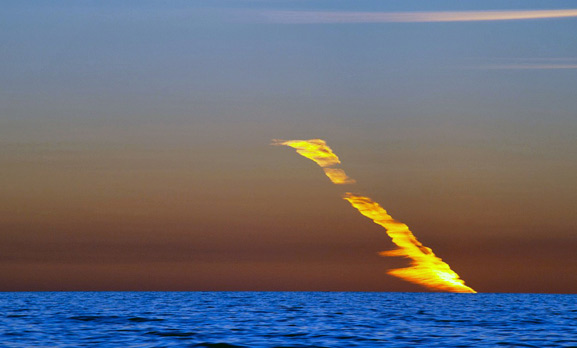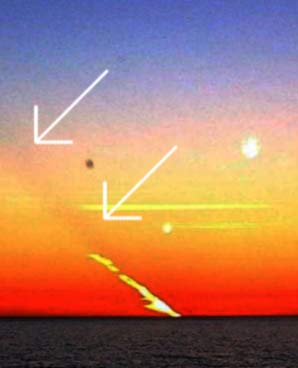Did a meteor plunge into the ocean near Perth? I'm thinking no.

I've been getting some emails and tweets alerting me to photos that purport to show the debris trail of a meteor after it apparently plunged into the ocean off the coast of Perth, Australia. After looking at the pictures, I'm pretty sure this is not a meteor, but an airplane contrail.
First, the picture, from the Australian news site News.com.au:

It's a lovely photo! It shows the ocean off to the west of Perth, a blue sky, and what appears to be some sort of cloud-like vapor or debris trail. That's probably not just an average cloud: it's very linear, and shows signs of being sheared apart by winds. Cirrus clouds can look like this, but generally aren't all alone in a blue sky. There are other types of linear clouds (like alto- and cirrocumulus) but those tend to appear in parallel bands.
 The cloud is also relatively low above the Earth's surface. In another photo from news.com.au, you can see the faint shadow of the cloud on the sky - I have inset that here, with the brightness and contrast stretched. The arrows mark the shadow (the bright blobs are most likely internal reflections in the camera, and the dark spot a piece of dust or something like that on the lens). The picture was taken at sunset, so the Sun was low. The shadow of the trail is being cast on haze and other stuff floating in the air above the cloud. Clearly, the trail isn't all that high above the Earth's surface.
The cloud is also relatively low above the Earth's surface. In another photo from news.com.au, you can see the faint shadow of the cloud on the sky - I have inset that here, with the brightness and contrast stretched. The arrows mark the shadow (the bright blobs are most likely internal reflections in the camera, and the dark spot a piece of dust or something like that on the lens). The picture was taken at sunset, so the Sun was low. The shadow of the trail is being cast on haze and other stuff floating in the air above the cloud. Clearly, the trail isn't all that high above the Earth's surface.
This doesn't mean it's not from a meteor, necessarily. A big rock plunging into the ocean might leave a trail (technically called a "train") like this. But I don't think that's what we're seeing. A big rock burning up in the atmosphere would've been really conspicuous, and seen by lots of people - especially at sunset near a major city like Perth. I'd also expect the train to be much longer than this; big meteors start burning up about 100 kilometers (60 miles) over the Earth, so the train would arc across more of the sky.
And no one saw that? Also, there are no confirmations from anywhere else of an impact or even observations of this. So my skeptic sense is tingling hard.
Also? It just really really looks like a typical airplane contrail! We see these all the time. When a plane flies over the horizon it can leave a contrail looking exactly like this, with perspective making it look like it's diving down into the ocean. It gets lit by the setting Sun, so it glows red, orange, or yellow. Thinking parsimoniously - using Occam's razor and looking at probabilities here - what's more likely: an airplane flying away from a big city, or a big rock burning up in our atmosphere that almost no one saw?
Furthermore, contrails have been mistaken for meteors and even missile launches in the past!
And I'll save the best for last: as I was wrapping up writing this post I did a Google search to see if anything new popped up, and sure enough there's an article with a witness saying he saw this cloud for a while before sunset, and it was clearly a contrail from an airplane. I don't put a lot of stock in eyewitness testimony in general, but that fits everything else we know.
So it seems far, far more likely to me that what we're seeing here is a contrail from an airplane being lit up in a lovely and spectacular way by the setting Sun, and not the smoky path of a bit of cosmic debris meeting its fate Down Under. That may not be as exciting, but it does help in a way: once you understand better what you're seeing in the sky (or in this case, not seeing), then you'll be in a better position to make a judgement if you do see something truly unusual. They may be rare, but spectacular meteors do sometimes flash across the sky. If you're fortunate enough to ever see one, wouldn't you rather be sure that's what you're seeing?
Related Posts:
- Peruvian "meteor" freaks out media
- An airplane con(spiracy)trail
- Followup: More on the LA contrail/missile
- Hit or missile
- Midwest megameteor makes media madness




























